![]() Wild Turkeys
Wild Turkeys ![]()
Meleagris gallopavo silvestris
|
|
|
|
|
Wild Turkey, Track, and Trail Pattern |
||
|
Click here to hear a turkey gobble. (36K WAV) |
||
|
|
|
|
|
|
|
|
Wild turkeys are native to the southeastern United
States. They have been introduced in many parts of the
west, including California. They prefer oak woodlands,
but are found in grasslands and pine forests as well.
They are swift runners and are wary of people. However, I have found them to be bold when they know there is food around. Turkeys have approached quite close to me when I am putting out food for other birds at feeders. Turkeys are polygamous. The male struts with his tail fanned to attract a harem. He fluffs up his feathers and drags his wing tips along the ground. This makes him look bigger. See photos below. You can often find the tracks made by the dragging wingtips. |
|
Where they naturally occur, wild turkeys were used by Native Americans as food. The turkey was almost chosen as the national bird of the USA. Wild turkeys do have the ability to fly. They are rather large and clumsy in flight, but are capable of it. I have seen turkeys wade a river rather than fly across, however. Perhaps it uses so much energy that they prefer to conserve rather than fly when they could just as well walk. (Or wade, in this case.) Turkeys lay eight to ten buff-colored eggs with brown spots. Eggs are laid in a shallow depression in the ground, lined with grass and leaves. I have found these nests in tall grass in spring. The typical call is a gobble, although turkeys use other calls as well.
|
|
|
|
|
This wild turkey track shows the detail of the pattern on the toes very well. The pebbly texture of the toes is similar to that found on porcupine and raven tracks. It is hard to see unless you find the track in good mud or fine soil. Three toes point forward. The round imprint where the three toes come together does not always show in the tracks. This is the metatarsal pad. Claw marks are visible on several toes in this picture. Turkeys have a fourth toe, which faces backward. But this does not always show in the tracks because they don't always place the foot entirely flat on the ground. Sometimes there will be a mark from the claw. |
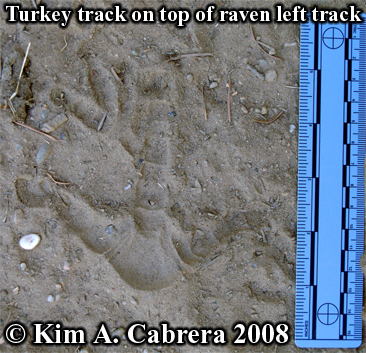 |
|
Perfect wild turkey track on top of the left track of a raven. This fine dusty soil is great for tracking! |
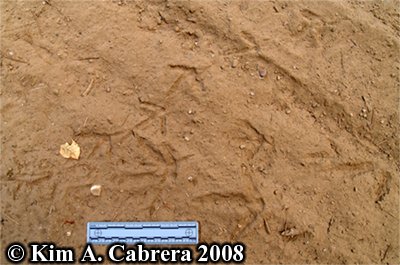 |
|
Adult and juvenile turkey tracks in dust. These tracks were found in July, when the young turkeys are less than half the size of the adults. The babies grow quickly, however. |
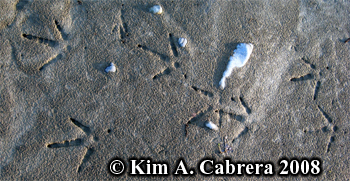 |
|
Several sets of wild turkey tracks in the sand next to the Eel River. There is also one clear raven track, in the upper left mid-corner. |
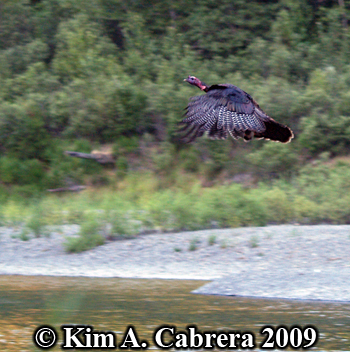 |
|
This turkey flew across the river after some of its companions did the same. It did not seem to be bothered by the human standing on the opposite river bank. It flew onto the bluff behind me and followed the other turkeys into the brush. They come down to the river to drink each evening before they retire to their evening roost in tall fir trees, far out of reach of predators. |
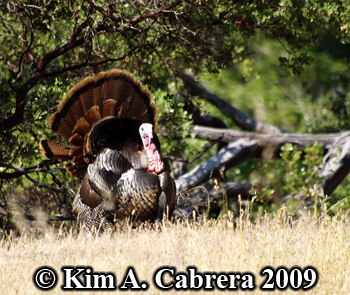 |
| Tom turkey showing his fan of feathers in bright sunlight. |
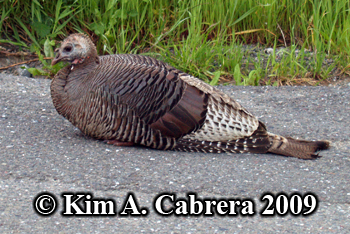 |
| A turkey hen resting on a paved roadside. |
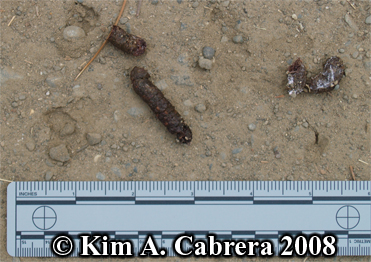 |
|
This small turkey scat was left by a very young bird. It was found in July. The chicks hatch beginning in June. |
|
These holes in the ground were made by turkeys sticking their beaks into it to find something to eat. |
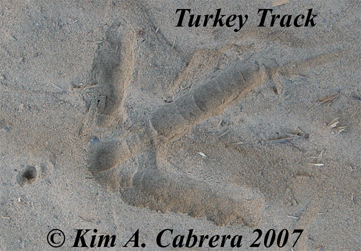 |
|
Another turkey track, in softer sandy soil. |
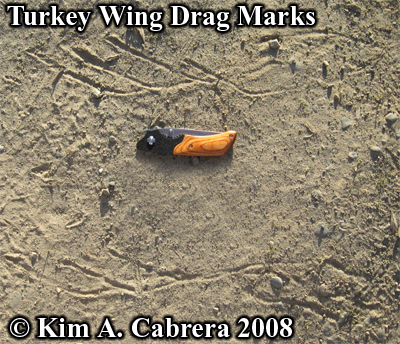 |
|
The marks above were made by the wings of a wild tom turkey. During the mating season, the toms strut with their tail feathers fanned and their wings dragging on the ground. This produces the marks. |
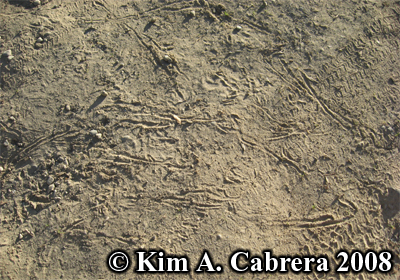 |
|
A tom turkey dragging the tips of his wings during the mating dance made these drag marks on the ground. These tracks show a turn. The toms often make abrupt turns while performing the mating dance. |
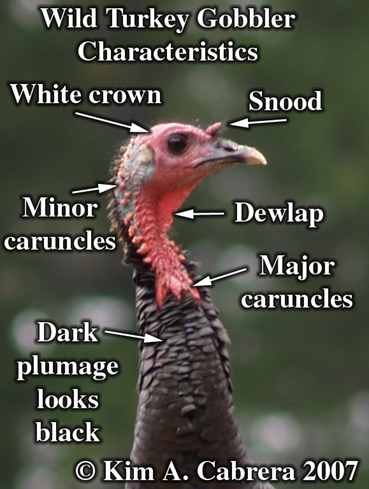 |
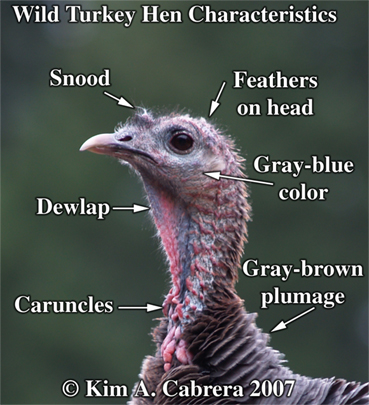 |
| How to identify wild turkey gobblers (males) and hens (females) | |
|
The male turkey has a more colorful head and darker plumage. He also has a spur on each leg and a "beard" of feathers on the chest. Young gobblers may not have the spur and beard yet. These youngsters are called "jakes." |
The female turkey has a more subtly colored head. She is able to hide better due to this natural camouflage. It is useful when she is sitting on her nest and needs to be concealed from predators. |
|
|
This wild turkey track shows the fine details of the foot. Nice, clear mud like this is ideal for tracking. This is the right foot. If you look closely, you will see the imprint of the hind toe, or hallux. The small indentation is from the nail on this toe. There is also a small, round imprint from the pad in the center of the foot. If this were the left track, the hallux imprint would be on the right side of the track, as it faces inward. |
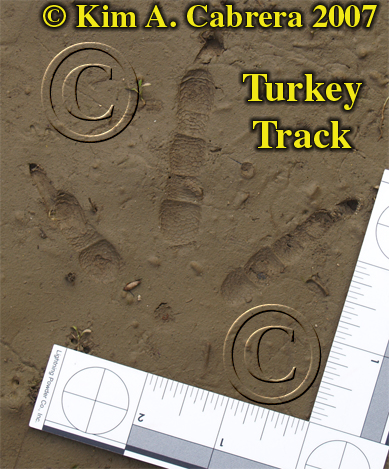 |
|
| Here is a turkey track showing its size. The ruler provides scale. When photographing tracks, it is a good idea to include some object that is easy to recognize as a scale. A ruler or tape measure is ideal, but you can use pennies, pens, or other objects whose measurements you can easily obtain. Straight-edged objects are best though. | |
|
|
Wild turkey tracks in a typical trail pattern. This perfect mud held nice, detailed tracks. |
| Wild turkey track in coarse river sand. All details are visible in this track, including the hallux. |
|
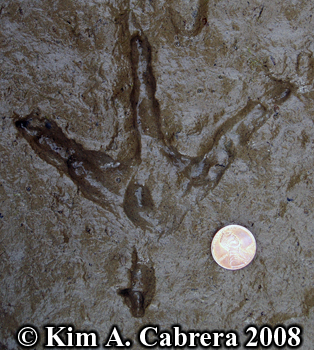 |
|
| Turkey track in fine river mud. Penny for scale is 3/4 inches across. | |
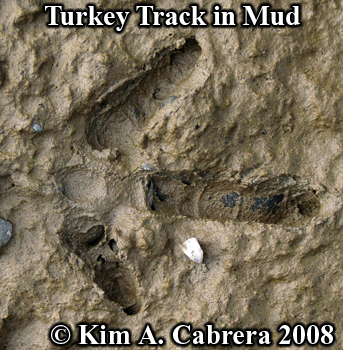 |
|
| A nearly perfect turkey track in firm mud. | |
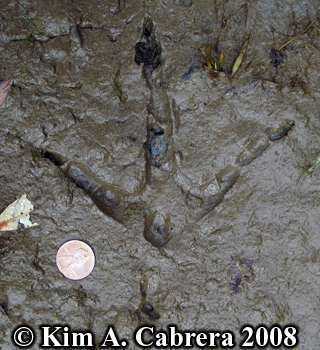 |
|
| A turkey track in fine mud along a river. The hallux shows up too. | |
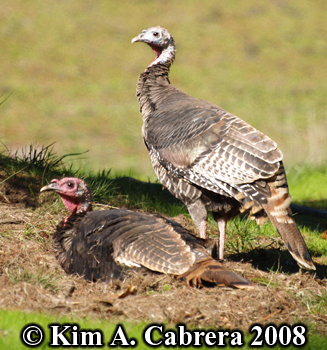 |
|
| Two turkeys resting under a pine tree on a hillside. | |
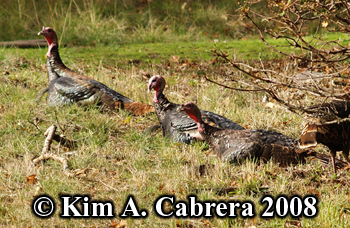 |
|
|
Several turkeys resting under an oak tree during the day. Turkeys feed during the day and take breaks to rest in places where they can watch their surroundings. |
|
|
|
|
| This tom turkey was on top of a rock. | |
|
|
|
| A tom turkey in the afternoon. | |
|
|
|
|
Pair of tom turkeys displaying their fans. |
|
|
|
|
|
Pair of tom turkeys displaying their fans. |
|
|
|
|
| This formless scat from a young wild turkey shows how diet can change the appearance of the scats. Scats normally look tubular. | This tiny scat was from a baby wild turkey less than a week old. |
|
|
|
|
A wild turkey scat from a male or Tom. |
|
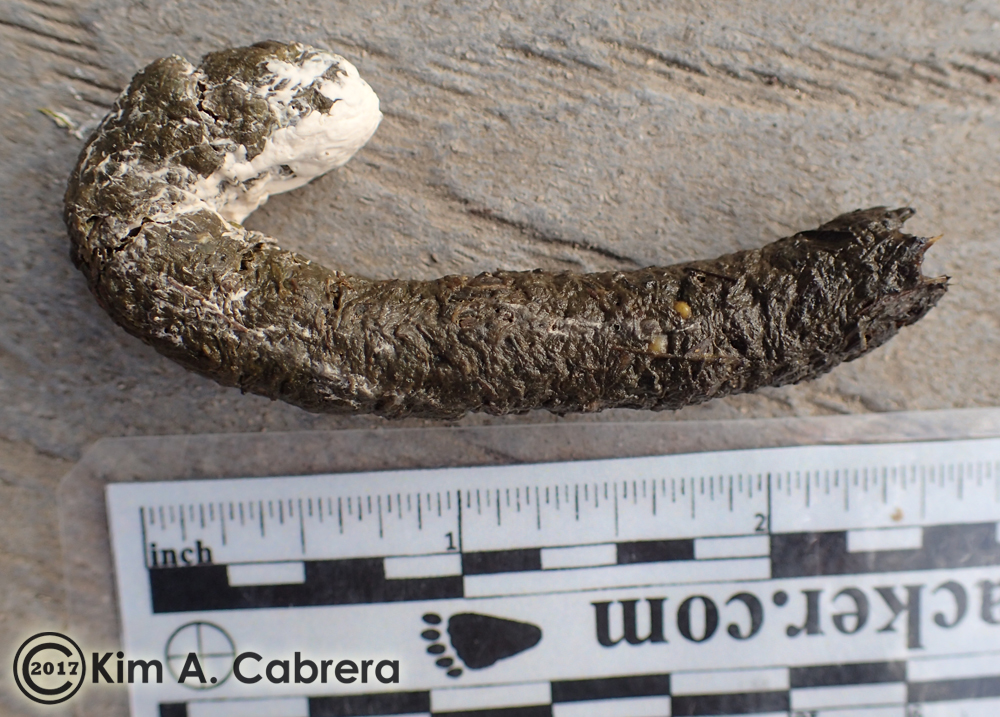 |
|
| A wild turkey scat from a male or Tom. | |
|
|
|
|
Wild turkey scat in early summer. This scat contains grass seeds, which the turkeys frequently feed on this time of year. |
|
|
|
|
|
Wild turkey scats of different ages and sizes. In late summer, you will find the scats of the young turkeys too. |
|
|
|
The three different scats on the left are provided to compare between different herbivore species. Deer scats are more oblong than those of rabbits. Turkeys are more tubular and larger than the others. All are composed of similar material. |
| A formless scat from a wild turkey. This one was due to diet. More moisture in the diet can change the normal consistency of scats. |
|
|
|
Wild turkey scat composed of blackberry parts and seeds. This is what gives it the purple color. This is a small scat because it came from a young chick. It was found in July when the babies are about a month old. |
|
|
|
|
Tom turkey showing his handsome fan of feathers. |
A group of hens and toms gather in a rock outcrop. |
|
|
Wild turkey track in soft mud. Notice the clarity of the pattern on the bottom of the foot. |
|
|
A nice, clear right track from a wild turkey. The tiny backward-facing toe is called the hallux. It does not always show up in the tracks. In the photos of turkey feet on this page, you can see what the hallux looks like. |
|
|
|
|
Where do turkeys go at night? They commonly roost in trees like this old Douglas fir. This gets them up off the ground, where they are more vulnerable to predators. High up in a tree, the turkeys can safely sleep the night away, knowing few predators can climb after them. |
|
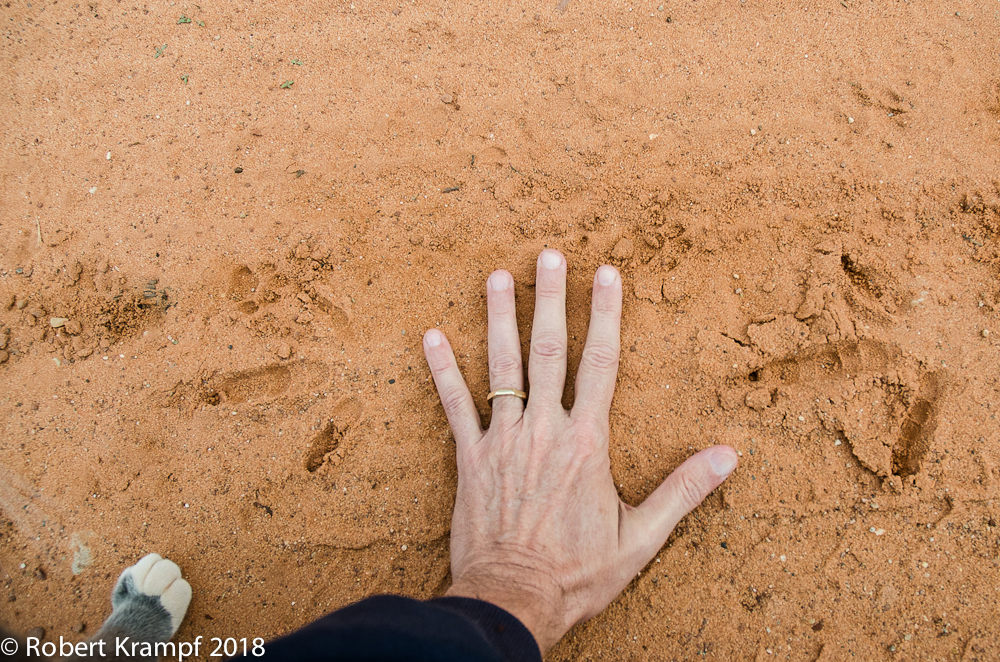 |
|
| Turkey
tracks and Little Bit's paw! |
|
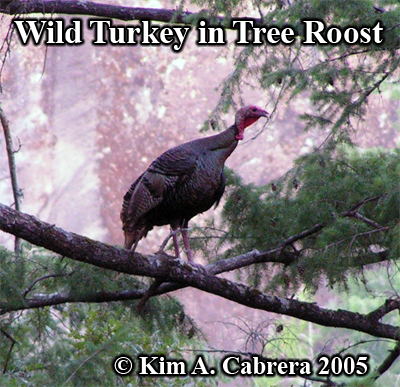 |
|
|
Wild turkey in a tree roost. This fir tree was over 100 feet tall. The branches easily supported the weight of the turkey. |
|
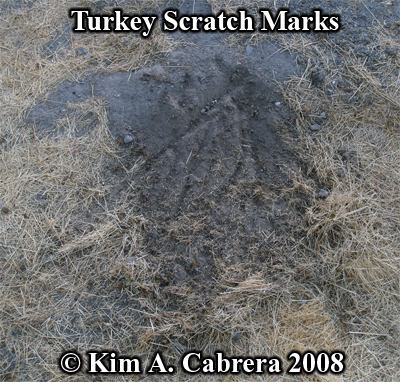 |
|
|
These scratch marks were made by turkey feet. The birds were scratching on the ground in a search for food. Insects and seeds are found this way. This photo was taken in late summer in a drought year. |
|
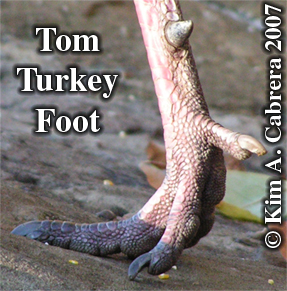 |
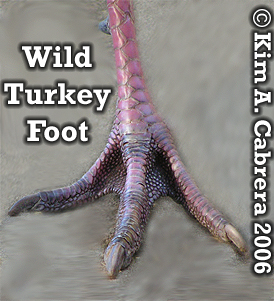 |
| The foot of a tom turkey. The males have the extra claw located high up on the leg. It is called a spur. They use this for fighting. The hind toe is called the hallux. | |
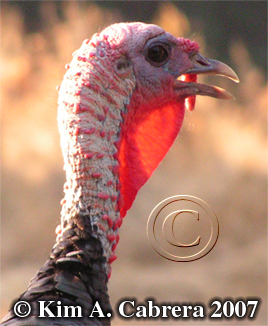 |
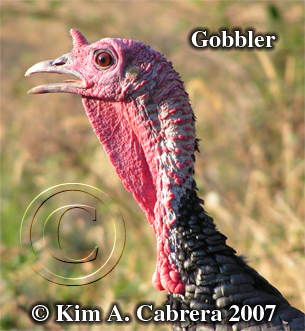 |
|
This gobbler has his snood extended. The snood can lengthen and shorten in seconds. |
A gobbler gobbling. The bright red color is often seen during the mating season when it serves to attract a mate. The major caruncles also get bigger. |
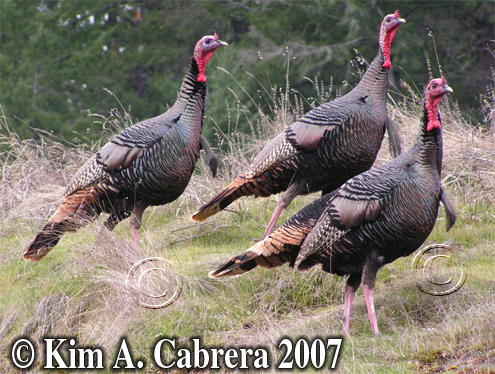 |
|
| These three gobblers paused on a grassy hillside to watch a group of hens nearby. | |
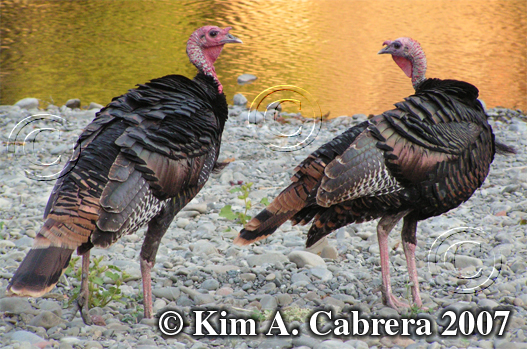 |
|
| A pair of Tom turkeys visiting the Eel River for a drink. Just before dusk, the turkeys go to the river and get a drink. Then they go up the hill to their favorite roost trees, where they spend the night, high out of the reach of predators. | |
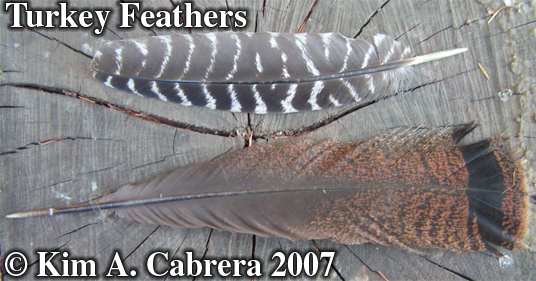 |
|
| Two types of turkey feathers. | |
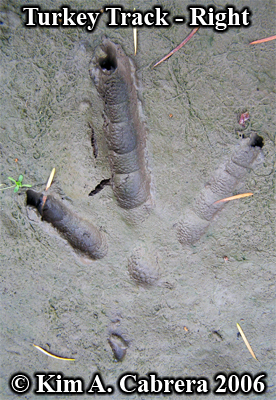 |
|
| A very clear wild turkey track in mud. The
details of the foot structure are easy to see. The small, backward-facing toe, known as the hallux, is also visible. |
|
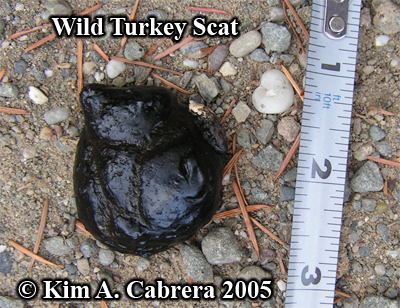 |
|
| A small, formless turkey scat. The consistency of scat is due primarily to the animal's diet. | |
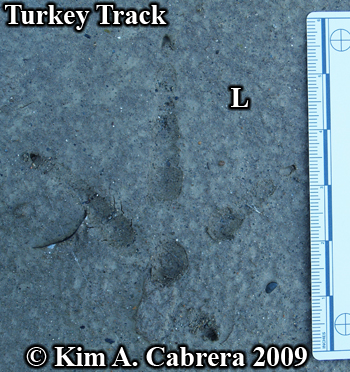 |
|
| Left wild turkey track in sand. | |
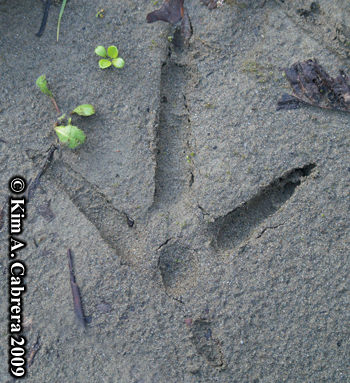 |
|
| A nice perfect wild turkey track in river sand. Left foot. | |
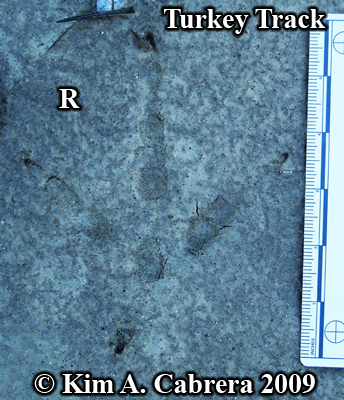 |
|
| The right track of a wild turkey in river sand. | |
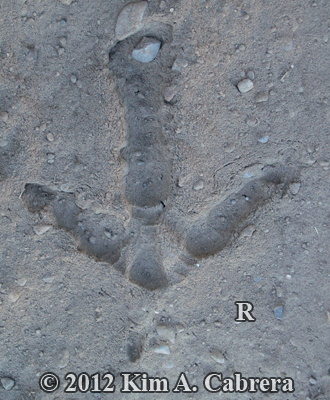 |
|
| A deep track in dust. This is the right track of a wild turkey. | |
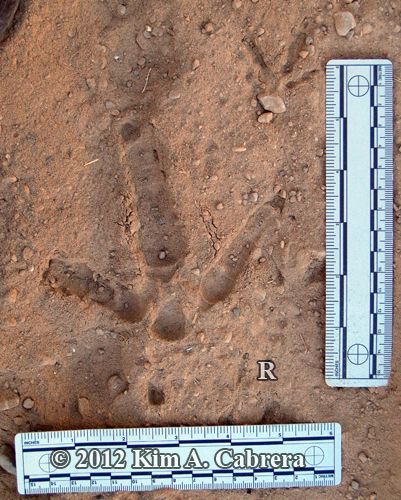 |
|
| This fine turkey track is from the right foot. In the upper right corner, there is a track left by a California quail. | |
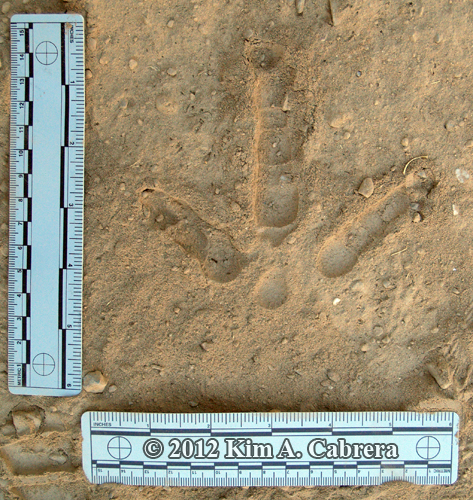 |
|
| Beautiful turkey track in the fine dust at the edge of a dirt road in summer. | |
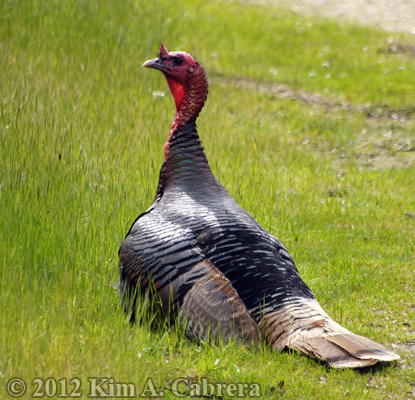 |
|
| A turkey resting in the afternoon sun | |
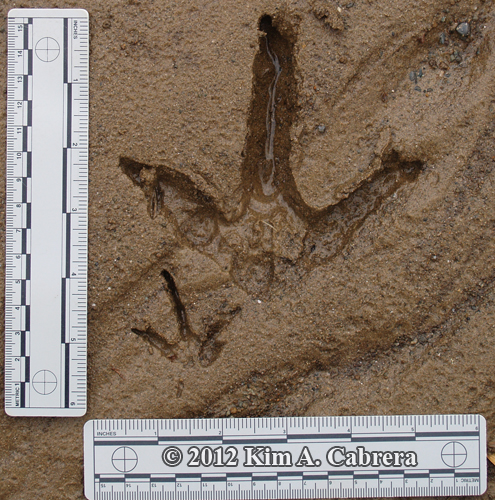 |
|
| Turkey track at the top and a smaller California quail track lower left | |
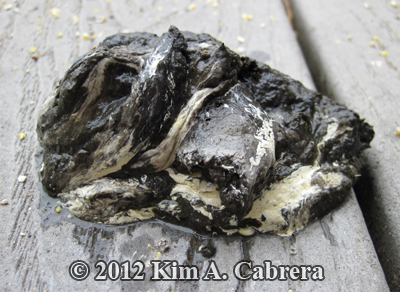 |
|
| One of the biggest turkey scats I have seen! | |
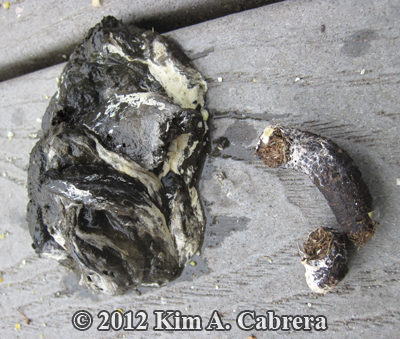 |
|
| The big turkey scat on the left compared to a normal-sized one on the right! | |



![]() Personal Notes on Wild Turkeys
Personal Notes on Wild Turkeys ![]()
| I have seen wild turkeys frequently. When I attended a recent tracking class at Henry W. Coe State Park in California, I camped in the park. The wild turkeys would call every morning and we would see them walking right by the campground. The males fan their feathers and call to the females. On the property I caretake, turkeys are sometimes seen in the trees and all over the grassy areas. I often hear them call from the tops of trees. For such a large bird, they can be difficult to see through the foliage. My cats watch the turkeys in fascination. Obviously the biggest bird they've ever seen! | |
| Wild turkeys live in my area and very frequently visit my home. I have a bird feeder where I feed small birds. However, once the turkeys learned about it, they became regular visitors too. I try to feed them away from the smaller birds because turkeys eat so much of the seed. Their favorite food is cracked corn, which also seems to be preferred by quail. | |
|
|
|
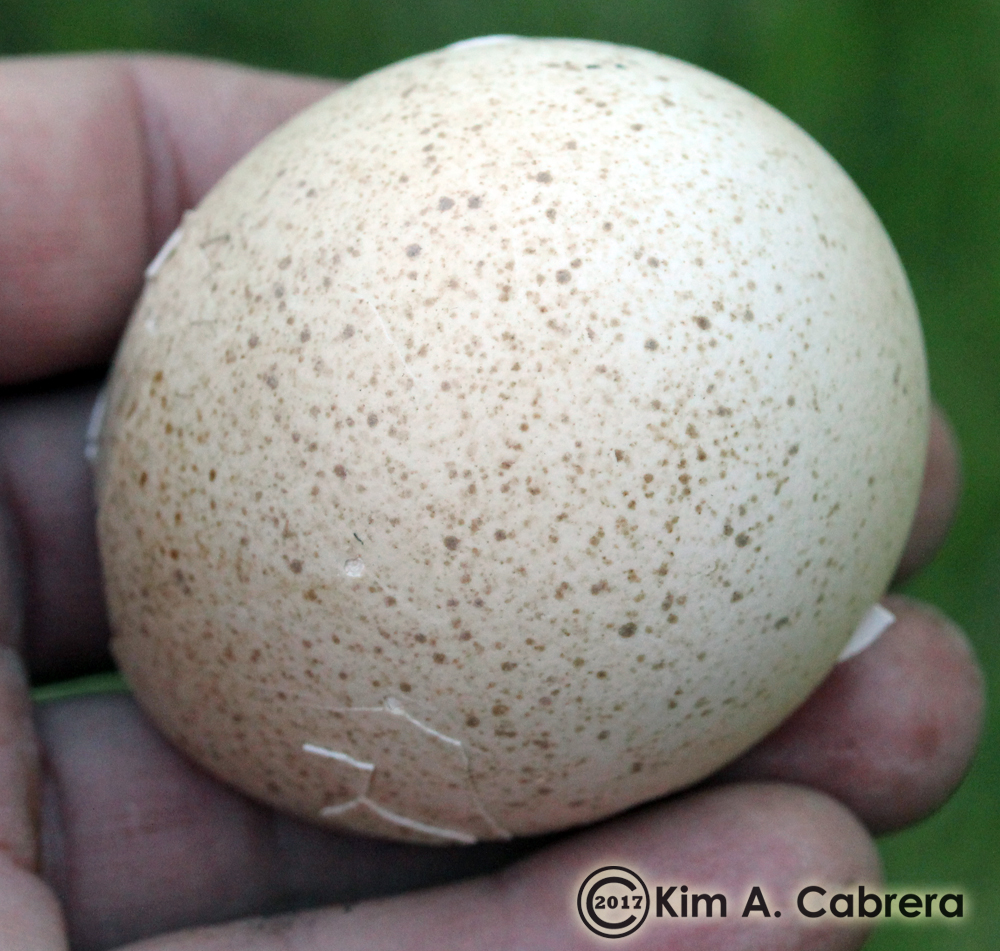 |
|
| turkey egg |
|
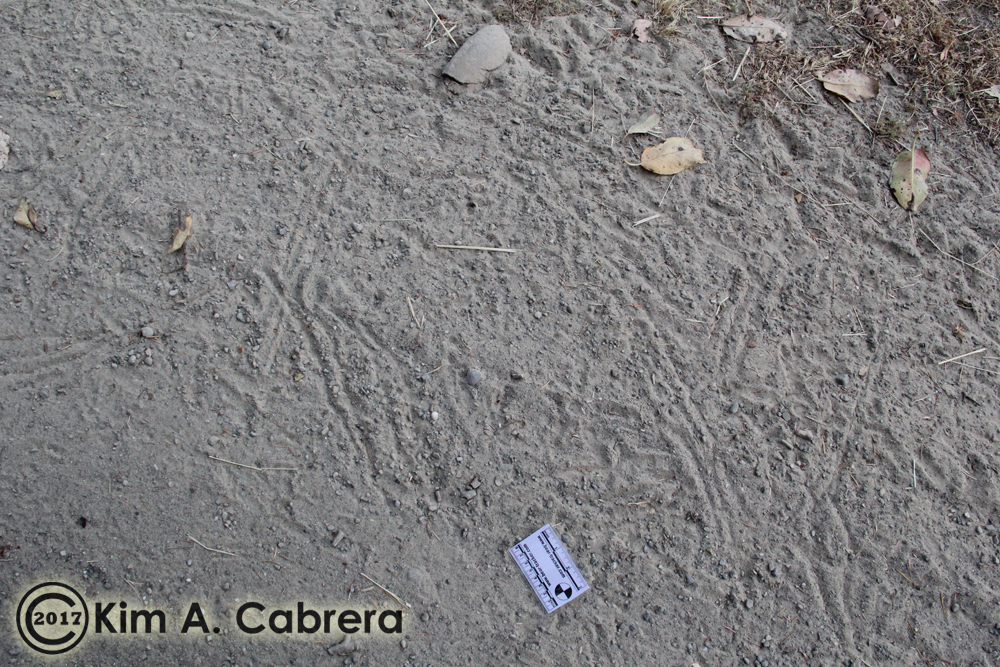 |
|
| wild turkey wing
drag marks |
|
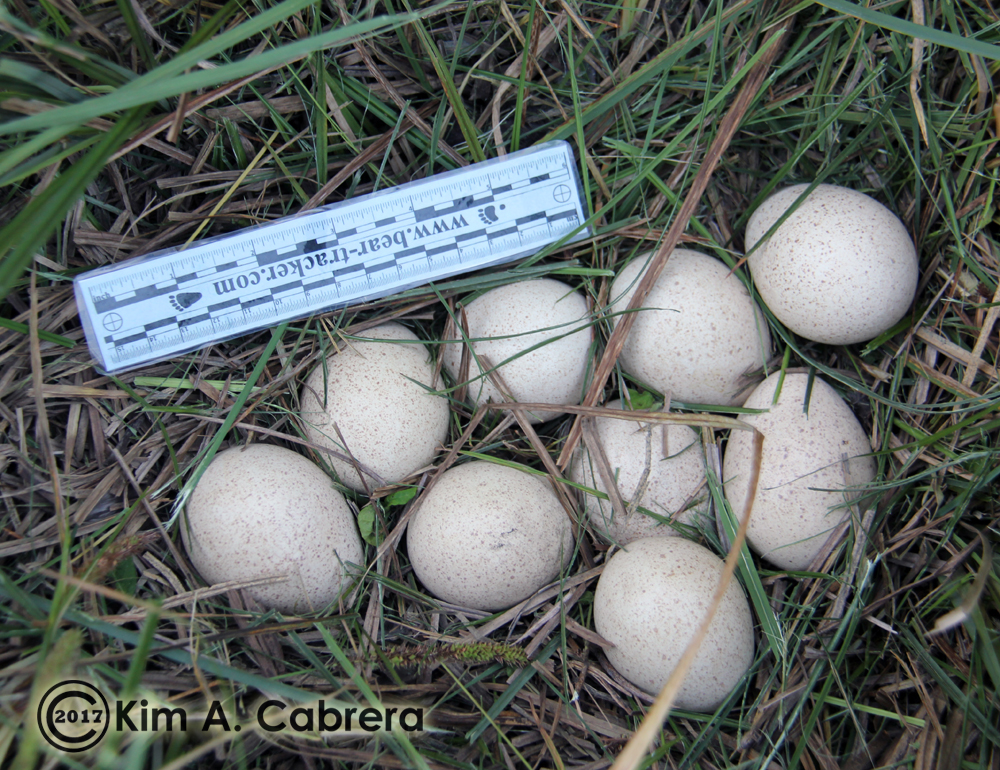 |
|
| wild turkey nest |
|
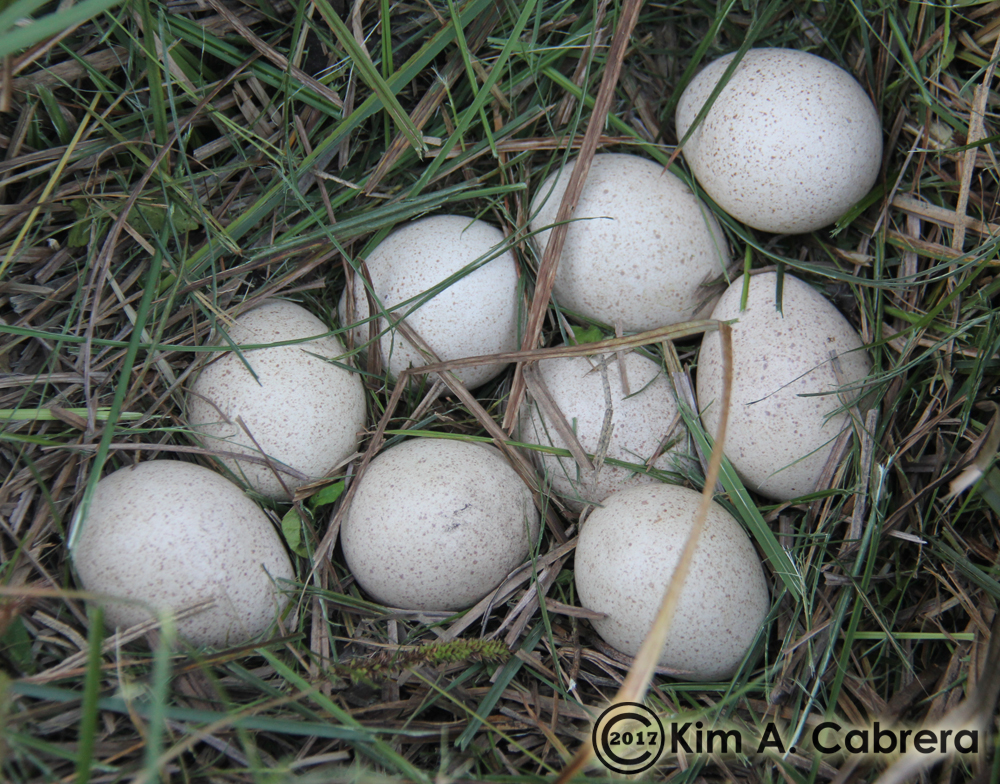 |
|
| wild turkey nest |
|
Here are some pictures of the turkeys that live in my "back yard."
![]()
![]()
![]()
![]()
![]()
Find wild turkey posters, greeting cards, t-shirts, hats, and more in my new store.
|
Visit Beartracker's Nature Store
online store at: www.dirt-time.com
Happy tracking!!
What else can you find in the nature store? Beartracker's animal tracks coloring book, T-shirts, sweatshirts, journals, book bags, toddler and infant apparel, mouse pads, posters, postcards, coffee mugs, travel mugs, clocks, Frisbees, bumper stickers, hats, stickers, and many more items. All with tracks or paw prints, or nature scenes. Custom products are available. If you don't see the track you want on the product you want, email me and I can probably create it. Proceeds from all sales go to pay the monthly fees for this web site. You can help support this site as well as get great tracking products! Thank you! |
| Find other tracking products: www.zazzle.com/tracker8459* |
| Also
visit these fine stores for more products of
interest:
NDN Pride shop - For Indian Pride items for all tribes. Custom items available on request. ASL Signs of Love - For anyone who uses or is learning ASL, American Sign Language. Custom name items and more are available here. Get Every Child Outdoors (Get E.C.O.) - My shop dedicated to nature and getting kids interested in nature and the outdoors. Sales from all stores give commissions to Beartracker's Animal Tracks Den, which helps keep this site online as a free service. We are celebrating ten years online this year! |
|
If you wish to help keep this site
online, donations are accepted through PayPal. |
|
|
||
 |
Got a wild turkey story? E-mail me and tell me about it. You are visitor number: Copyright
© 1997, 2012, 2018. Text, photos, and drawings by
Kim A. Cabrera. |
 |
|
|
||
Copyright © 1997, 2018. Kim A. Cabrera - Desert Moon Design
Page last updated: March 26, 2018.
![]()